作者:刘禹 范臻佳 许冠群 丁秋兰 王学锋
【摘要】目的:提高临床医师及检验科医师、技师对获得性凝血因子V缺陷症(acquired factor V deficiency,AFVD)的认知。方法:收集2010年12月至2019年4月上海交通大学医学院附属瑞金医院收治的AFVD患者5例,总结其临床症状、实验室检查、诊治经过及转归情况。收集152例非牛凝血酶源性AFVD患者性别、年龄、诱发因素、凝血功能、治疗方案及转归情况,使用SPSS23.0软件进行统计学分析。结果:我院收治的5例AFVD患者均为男性,各有不同程度的出血症状。实验室检查均有活化部分凝血活酶时间(activated partial thromboplastin time,APTT)及凝血酶原时间(prothrombin time,PT)升高、凝血因子V活性(FV:C)降低及凝血因子V(FV)抑制物Bethesda法定量阳性。4例患者经治疗后出血症状消失,最终康复出院,另1例患者出院后失访。常见的治疗方案分为止血治疗与抑制物清除治疗两方面。止血治疗中最常使用的是新鲜冰冻血浆。抑制物清除治疗中最常使用的是类固醇与环磷酰胺。结论:AFVD较为罕见,临床表现各不相同。患者转归情况与诱发因素有关。
【关键词】获得性凝血因子V缺陷症;抑制物;出血;治疗
凝血因子V(coagulation factor V,FV)是人体内凝血途径中重要的组成部分之一。在凝血途径中作为辅因子,与钙离子、磷脂及活化的凝血因子X形成凝血酶原酶复合物,进而激活凝血酶原。FV主要是在肝脏合成,也可在巨核细胞中合成。除了在正常人血浆中,FV还可出现在巨核细胞和血小板的α颗粒中。相较于获得性凝血因子Ⅷ缺乏症而言,获得性凝血因子V缺乏症(acquired factor V deficiency,AFVD)更为少见。全球共报告约240例AFVD。AFVD患者的临床表现各不相同,可无任何临床症状,亦可有危及生命的大出血,亦或是血栓形成。有部分学者认为AFVD患者的症状与FV活性(FV:C)及活化部分凝血活酶时间(activated partial thromboplastin time,APTT)有关[2]。AFVD的诱发因素中最为常见的是接触牛凝血酶。随着医疗技术的发展,纤维蛋白封闭剂中已不再使用牛凝血酶,因此牛凝血酶源性AFVD的发生率已大大减少。而非牛凝血酶源性AFVD中,常见诱因有药物使用、手术治疗、恶性肿瘤等。
我院近年来共收治了8例AFVD患者。本文选择其中的5例住院患者,希望以此提高临床医师及检验科医师、技师对AFVD的认知。
一、临床病例资料
1. 病例1:男性,71岁,2010年12月9日至我院就诊,主诉进食后中上腹部不适伴呕血黑便半月。当地医院查胃镜示距门齿43cm隆起样新生物,贲门占位,病理示腺癌。我院门诊以“贲门恶性肿瘤”收治入院。术前常规凝血功能示APTT 63.5秒(参考范围:22.3~38.7 秒),PT 43.4秒(参考范围:10.0~16.0秒)。遂予以维生素K肌注,同时检测凝血因子活性全套。凝血因子活性示FV:C 5.8%(参考范围:50.0~150.0%),FV抑制物4.0BU/mL(参考范围:阴性),余均正常。维生素K治疗一周后,患者凝血功能未见明显好转,建议患者于血液科纠正凝血功能后再行手术治疗。12月21日,患者出院,遂失去联系。
2. 病例2:男性,84岁,2018年5月28日至我院就诊。主诉无明显诱因下高热伴血尿九天、皮肤瘀斑一月余。患者于5月19日至当地医院就诊,血常规示白细胞10.2×109/L(参考范围:3.97~9.15×109/L),中性粒细胞80.1%(参考范围:50.0%~70.0%),血红蛋白104g/L(参考范围:131~172g/L),血小板203×109/L(参考范围:85-303×109/L),尿常规示白细胞满视野(参考范围:0~5/HP),红细胞++++(参考范围:阴性)。经治疗后症状有所好转,后复发。门诊以“凝 血功能异常”收治入院。凝血功能示APTT 134.5秒,PT60.0秒,APTT纠正试验即刻不纠正,孵育2小时后不纠正,PT纠正试验即刻不纠正,FV:C 0.5%,FV抑制物 32.0BU/mL。输注新鲜冰冻血浆200mL/d。治疗三天后凝血功能未见明显好转,口服加用甲泼尼松龙60mg/d。患者凝血功能逐渐恢复,瘀斑消失,尿隐血试验转为阴性。6月26日,患者康复出院,建议定期血液科门诊随访。
3. 病例3:男性,78岁,2018年12月18日至我院就诊。主诉反应迟钝10年,加重4天。我院门诊以“阿尔兹海默症”收治入院。凝血功能示均正常。给予头孢呋辛及来立信抗感染,兰苏化痰,长春西汀活血,澳辅泰营养神经。12月21日,患者手掌心出现瘀斑,凝血功能示APTT 122.7秒,PT 60.0秒。遂停用头孢呋辛,并予以维生素K 30mg/d及凝血酶原复合物(PPSB)600IU/d。治疗后凝血功能未见明显好转并出现牙龈出血症状,凝血因子示FV:C 1.1%,FV抑制物16.0BU/mL。输注新鲜冰冻血浆300mL/d,止血芳酸0.1g兑水漱口改善牙龈出血,口服强的松10mg bid。激素治疗后患者凝血功能略有改善。2019年1月14日,加大激素用量,口服泼尼松片 1mg/(kg·d)。2019年1月26日,凝血功能示APTT 34.3 秒,PT 14.5 秒。1月28日,患者康复出院,建议定期血液科门诊随访。
4. 病例4:男性,55岁,2019年2月4日至我院就诊。主诉皮肤青紫伴肿胀疼痛1月余。患者1月中旬无明显诱因下出现左侧臀部大片青紫,范围约20cm×15cm,压之不褪色,边界清晰,病灶肿胀,伴疼痛,后逐渐蔓延至双下肢,出现大片皮肤青紫、疼痛,伴关节肿胀。至当地医院凝血功能示异常,予以新鲜冰冻血浆及PPSB治疗,无明显改善。我院急诊凝血功能示APTT 180.0秒,PT 60.0秒。2月7日凝血因子示FV:C 1.0%,FV抑制物8.0BU/mL。给予静脉滴注甲强龙80mg/d,PPSB 2000IU bid。2月22日,凝血功能示APTT 40.4秒,PT 15.6秒,FV:C 26.5%,FV抑制物1.0BU/mL。2月25日,患者出现少尿症状,我院急诊以“急性肾衰竭”收治入院。给予新鲜冰冻血浆、纤维蛋白原、PPSB、红细胞悬液、冷沉淀改善凝血功能,头孢呋辛钠750mg bid抗感染。患者凝血功能异常加重,几日后凝血功能示APTT 180.0秒,PT 60.0秒,FV:C 0.8%,加用环磷酰胺200mg/w。患者凝血功能未见明显好转3月5日,停用头孢呋辛钠。3月9日,FV抑制物阴性,临床就其原发病继续给予治疗。
5. 病例5:男性,55岁,2019年3月26日至我院就诊。主诉肉眼血尿2月余。患者2月于当地医院就诊,无尿频尿急尿痛,查B超示:右肾实质占位性病变,错构瘤?双肾MR示:右肾中上极占位,考虑恶性肿瘤可能。凝血功能示APTT 109.6秒,PT 56.4秒,FV:C 0.8%,FV抑制物4.0BU/mL。术前输注新鲜冰冻血浆800mL,手术当天输注新鲜冰冻血浆1000mL,单采血小板1U后进行手术,术后给予止血芳酸0.6g+生理盐水250mL qd。4月8日行经腹腹腔镜右肾根治性切除术。4月11日,凝血因子示FV:C 43.4%,FV抑制物阴性,患者症状好转,予以出院,建议定期血液科门诊随访。
二、资料与方法
1. 检索策略:在中国知网及万方数据平台上以“获得性凝血因子V缺乏症”、“获得性凝血因子V抑制物”等为关键词进行搜索,同时在EMBASE,PUBMED上以“acquired factor V deficiency”、“acquired factor V inhibitors”、“anti-factor V antibodies”和“factor V autoantibodies”等为关键词进行搜索。
2. 排除标准:通过对病例报告的仔细阅读及整理,共获得AFVD病例240例。考虑到目前纤维蛋白封闭剂中已不再使用牛凝血酶,牛凝血酶源性AFVD的发生率已大大减少,其临床意义较低,因此将牛凝血酶源性AFVD病例剔除,未统计及整理入本文。经过筛选后,本文将对筛选后的152例病例的病史[1,3-95]进行统计及整理。本文对有效病例筛选的流程图见图1。
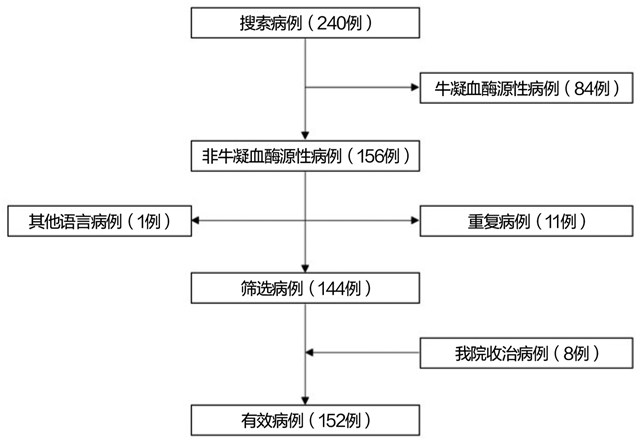
图1. 有效病例筛选流程图
3. 统计学分析:本研究使用SPSS 23.0软件进行统计学分析。各项结果均不符合正态分布,以“中位数,(下四分位数-上四分位数)”表示。组间比较采用Mann-Whitney U检验。率的组间比较采用卡方检验。P<0.05为差异有统计学意义。
三、结果
由于病史来自于不同中心的病例报告或系统评价,各中心的检测上(下)限有较大差异。因此为了保证数据量,我们在统计完成后对结果做了以下处理APTT≥100.0秒均记为100.0秒,PT≥45.0秒均记为 45.0秒,FV:C≤1.0%均记为1.0%(其中剔除了20例结果,如“≤2.0%”及“≤6.0%”等)。部分中心并未给出患者治愈时间,故在后续分析中未考虑平均治愈时长等相关指标,仅将治愈率纳入分析。
1. 性别:男性组与女性组各指标汇总及组间差异见表1。152例AFVD患者中,男性101例(占66.4%),女性51例(占33.6%),男女比约为2:1。男性组与女性 组各指标的组间差异无统计学意义(p均>0.05)。
表1. 男性组与女性组各指标汇总及组间差异
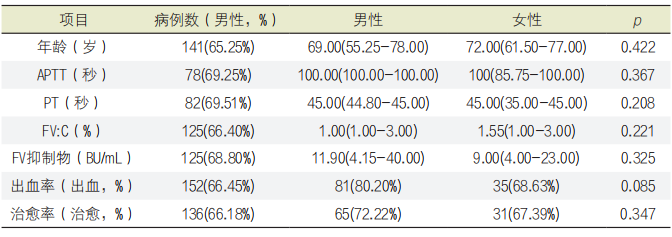
2. 年龄:152例AFVD患者中,11例缺失“年龄”数据。综合考虑我国对年龄段的划分标准与AFVD的好发年龄等因素,选取60岁为基准线,将<60岁患者定义为中青年组,≥60岁患者定义为老年组。中青年组与老年组各指标汇总及组间差异见表2。中青年组与老年组各指标的组间差异无统计学意义(p均>0.05)。
表2. 中青年组与老年组各指标汇总及组间差异

3. 出血症状:152例AFVD患者中,有出血症状者116例(占76.32%),有血栓症状者6例(占3.95%),无明显症状者33例(占21.71%),其中有3例患者同时出现了出血症状及血栓症状。有出血症状组与无出血症状组各指标汇总及组间差异见表3。有出血症状组与无出血症状组间APTT、PT和FV:C的差异有统计学意义(p分别为0.004、0.012与0.001),余无统计学意义(p均>0.05)。
表3. 有出血症状组与无出血症状组各指标汇总及组间差异

4. 出血部位:116例有出血症状的AFVD患者中,8例缺失“出血部位”数据,出血部位汇总及其治愈率见表4。常见的出血部位分别为泌尿生殖道出血(占 31.03%,治愈率为80.56%)、皮肤瘀斑(占18.10%,治愈率为85.00%)及胃肠道出血(占14.66%,治愈率为35.71%)。
表4. 有出血症状的AFVD患者的出血部位汇总及其治愈率*
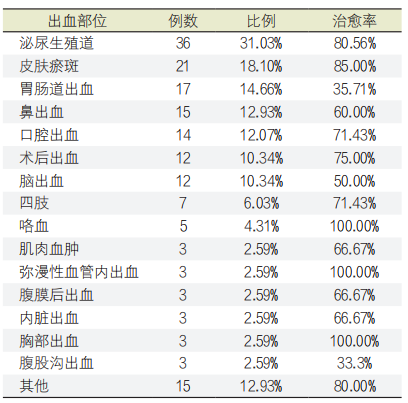
* 部分患者存在多个部位同时出血的现象
5. 诱发因素:152例AFVD患者中,34例患者未发现明显诱发因素,诱发因素汇总及其治愈率见表5。最常见的诱发因素为药物(占34.87%,治愈率为83.02%)、手术(占26.97%,治愈率为79.49%)及感染(占13.16%,治愈率为63.16%)。
表5. AFVD的诱发因素汇总及其治愈率*
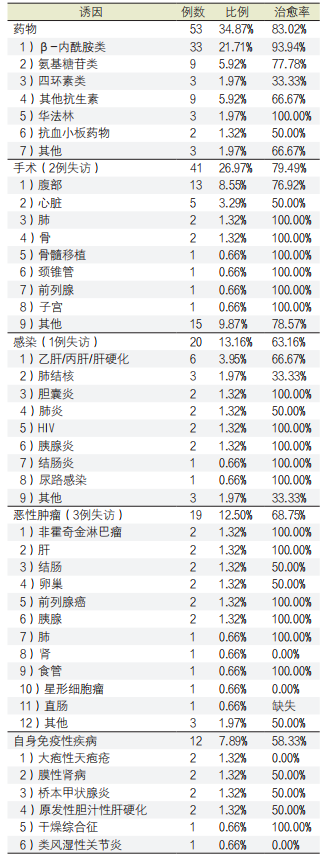
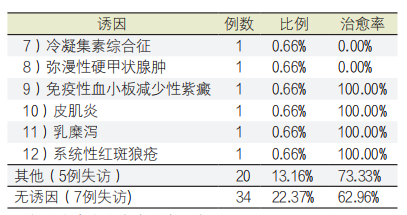
* 部分患者存在多个诱发因素
6. 治疗方案:常见的获得性凝血因子缺乏症的治疗方法分为两部分,即止血治疗与抑制物清除治疗两方面。AFVD的止血治疗方案汇总及其治愈率见表6,抑制物清除方案汇总及其治愈率见表7。止血治疗中最常见的为新鲜冰冻血(占49.34%,治愈率为72.60%)与维生素K(占23.68%,治愈率为77.14%)。抑制物清除治疗中 最常见的为类固醇(占55.26%,治愈率为79.76%)与环磷酰胺(占21.71%,治愈率为72.73%)。
表6. AFVD的止血治疗方案汇总及其治愈率*
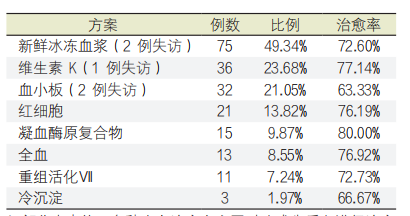
* 部分患者使用多种止血治疗方案同时(或先后)进行治疗
表7. AFVD的抑制物清除治疗方案汇总及其治愈率*

* 部分患者使用多种抑制物清除治疗方案同时(或先后)进行治疗
7. 转归情况:152例AFVD患者中,16例缺失“结局”数据。余136例AFVD中96例患者治愈,40例患者未治愈。其中未治愈主要包括抑制物长期存在或患者因出 血或(和)血栓而导致死亡。治愈组与未治愈组各指标汇总及组间差异见表8。治愈组与未治愈组各指标的组间差异无统计学意义(p均>0.05)。
表8. 治愈组与未治愈组各指标汇总及组间差异

四、结论
获得性凝血因子V缺乏症(acquired factor V deficiency,AFVD)极为少见,按诱发因素可分为牛凝血酶源性AFVD与非牛凝血酶源性AFVD。随着医疗技术的发展,纤维蛋白封闭剂中已不再使用牛凝血酶,因此牛凝血酶源性AFVD的发生率已大大减少。而非牛凝血酶源性AFVD多见于老年男性患者中。男性发病年龄为69.00(55.25-78.00)岁,女性发病年龄为72.00(61.50-77.00))岁,男女发病率之比约为 2:1(101:51)。
AFVD的诊断依据主要有以下几个:1)PT及APTT延长,且与正常血浆混合后无法纠正;2)FV:C降低,FV抑制物检测阳性;3)无家族出血史及相关病史。在实验室检查中,FV抑制物的检测主要使用Bethesda法。与FⅧ抑制物不同的是,FV抑制物与FV反应无需在37℃水浴孵育中进行。
在男性组与女性组、中青年组与老年组间,患者各指标的组间差异均无统计学意义(p均>0.05)。有出血症状组与无出血症状组患者的活化部分凝血活酶时间(activated partial thromboplastin time,APTT)、凝血酶原时间(prothrombin time,PT)及凝血因子V活性(FV:C)的组间差异有统计学意义(p分别为0.004、0.012与0.001)。治愈与未治愈两组间各结果的差异无统计学意义(p均>0.05)。
这一系列结果提示在检测上(下)限可达到较高(低)值的前提下,APTT、PT及FV:C的结果可预测AFVD患者的出血风险,从而达到减少其出血事件的发生数量,但并不可将这些结果作为评估AFVD患者转归情况的指标。
从现有报道案例来看,AFVD有多个诱发因素且不同诱发因素导致的AFVD的治愈率并不相同。但由于AFVD较为罕见,对其诱发因素的研究尚浅,该结论可靠性尚需更多发病机制研究来验证。就现有报道而言,有出血症状的AFVD临床表现为不同出血部位的治愈率也各不相同,但此结论也与各中心使用不同治疗方案有关。AFVD治疗方案分为止血治疗与抑制物清除治疗两方面。止血治疗中,随着对药物组成和疾病认知的增加,我们更倾向于使用新鲜冰冻血浆与血小板,而不建议使用本系统评价中36例病例中使用的维生素K。抑制物清除治疗中,由于缺乏FV抑制物的治疗指南,我们建议参考《凝血因子Ⅷ/Ⅸ抑制物诊断与治疗中国指南(2018 年版)》[96]。
但由于非牛凝血酶源性AFVD极为罕见,同时本文选取的案例报道大多来源于各中心个案报道,一部分来源于其他系统评价(存在较大异质性),本文的统计结果可能与真实结果存在部分差异。希望随着科技发展,未来能对非牛凝血酶源性AFVD有一个更全面、更深层次的认知。
参考文献
Ferguson J H, Jr J C, Howell D A. A circulation inhibitor (anti-AcG) specific for the labile factor-V of the blood-clotting mechanism[J]. Blood, 1958, 13(4):382-397.
Ang A L, Kuperan P, Ng C H, et al. Acquired factor V inhibitor. A problem-based systematic review[J]. Thrombosis and Haemostasis, 2009, 101(5):852-859.
Lopez V, Pflugshaupt R, Bütler, R. A Specific Inhibitor of Human Clotting Factor V[J]. Acta Haematologica, 1968, 40(5):275-285.
Handley D A, Duncan B M. A Circulating Anticoagulant Specific for Factor V [J]. Pathology, 1969, 1:265-272.
Feinstein D I, Rapaport S I, Mcgehee W G, et al. Factor V anticoagulants: Clinical, biochemical and immunologic observations[J]. Journal of Clinical Investigation, 1970, 49(8):1578-1588.
Feinstein D I, Rapaport S I, Chong M M. Factor V inhibitor: report of a case, with comments on a possible effect of streptomycin[J]. Annals of Internal Medicine, 1973, 78(3):385-388.
Onuora C A, Lindenbaum J, Nossel H L. Massive hemorrhage associated with circulating antibodies to factor V [J]. The American Journal of the Medical Sciences, 1973, 265(5):407-417.
Nilsson I M, Hedner U, Ekberg M et al. A circulating anticoagulant against factor V [J]. Acta Medica Scandinavica, 1974, 195:73-77.
Stenbjerg S, Husted S, Mygind K. A circulating factor V inhibitor: possible side effect of treatment with streptomycin [J]. European Journal of Haematology, 1975, 14(4):280-285.
Crowell E B. Observations on a factor-V inhibitor[J]. British Journal of Haematology, 1975, 29(3):397-404.
Bryning K, Leslie J. Factor V inhibitor and bullous pemphigoid [J]. British Medical Journal, 1977, 2:677-678.
Coots M C, Muhleman A F, Glueck H I. Hemorrhagic death associated with a high titer factor V inhibitor [J]. American Journal of Hematology, 1978, 4(2):193-206.
LANE, Thomas A. Factor V Antibody and Disseminated Intravascular Coagulation[J]. Annals of Internal Medicine, 1978, 89(2):182-185.
Lust A, Bellon A. A Circulating Anticoagulant Against Factor[J]. Acta Clinica Belgica, 1978, 33(1):62-65.
Chediak J, Ashenhurst J B, Garlick I, et al. Successful Management of Bleeding in A Patient with Factor-V Inhibitor by Platelet Transfusions[J]. Blood, 1980, 56(5):835-841.
Abe T, Kazama M, Itokazu K, et al. A Case of Sigmoid Cancer Who Acquired Factor V Inhibitor Producibility and Treated with Factor VIII Inhibitor Bypassing Activity Preparation FEIBA: —with Bibliographic Review— [J]. Rinsho Ketsueki, 1980, 21.
Hida K, Sakamoto S, Takaku F et al (1980) A case of acquired coagulopathy due to factor V inhibitor. Rinsho Ketsueki 21:1589-1596
Lerolle D, Dreyer-Dufer C, Allain J P. A circulating inhibitor specific to factor V. Clinical, biological and therapeutic study[J]. La Nouvelle Presse Mé dicale, 1981, 10(18):1483-7.
Kuto M, Izuchi Y, Deguchi K, et al. An inhibitor against factor V occurring postoperatively in a case of pancreatic cancer[J]. Nihon Ketsueki Gakkai Zasshi Journal of Japan Haematological Society, 1981, 44(4):938.
Vickars L M, Coupland R W, Naiman S C. The response of an acquired Factor V inhibitor to activated Factor IX concentrate[J]. Transfusion,1985, 25(1):51-53.
Chong L L, Wong Y C. A case of factor V inhibitor [J]. American Journal of Hematology, 1985, 19(4):395-399.
Chiu H C, Rao A K, Beckett C, et al. Immune complexes containing factor V in a patient with an acquired neutralizing antibody[J]. Blood, 1985, 65(4):810-818.
Nesheim M E, Nichols W L, Cole T L, et al. Isolation and study of anacquired inhibitor of human coagulation factor V [J]. Journal of Clinical Investigation, 1986, 77(2):405-415.
Brandt J T, Britton A, Kraut E. A spontaneous factor V inhibitor with unexpected laboratory features [J]. Archives of Pathology & Laboratory Medicine, 1986, 110(3):224-7.
Lazarchick J, Wolff C M, Pepkowitz S H, et al. Factor V inhibitor associated with immune complex formation.[J]. Archives of Pathology & Laboratory Medicine, 1986, 110(5):448.
Massignon D, Roullit S, Espinouse D, et al. Occurrence of a circulating anticoagulant, factor V inhibitor after surgical intervention[J]. Annales Franaises Danesthèsie Et De Rèanimation, 1989, 8(1):70-72.
Okajima A, Horii J, Nasu K, et al. [Factor V inhibitor with double cancer] (Engl abstract)[J]. [Rinsh ō ketsueki] The Japanese journal of clinical hematology, 1989, 30(4):514-9.
Grigg A P, Dauer R, Thurlow P J. Bleeding due to an acquired inhibitor of platelet associated factor V [J]. Australian & New Zealand Journal of Medicine, 1989, 19(4):310-314.
Taillan B, Fuzibet JB, Vinti H et al (1989) Factor V inhibitor in celiac disease. Am J Med 87:360
Gordon B, Haire W, Duggan M, et al. Factor V inhibitor developing after liver transplantation in a 3-year-old child[J]. Pediatrics, 1991, 88(1):156-159.
Buclin T, Schmidt P M, Hauert J, et al. [Acquired factor V inhibitor treated with intravenous immunoglobulins].[J]. Schweizerische Medizinische Wochenschrift, 1992, 122(51-52):1968.
Kapur A, Kelsey P R, Isaacs P E. Factor V inhibitor in thrombosis.[J]. American Journal of Hematology, 1993, 42(4):384-388.
Smid W M, De Wolf J T M, Nijland J H, et al. Severe bleeding caused by an inhibitor to coagulation factor V:a case report[J]. Blood Coagulation & Fibrinolysis, 1994, 5(1):133-138.
Denis A, Baudeau C, Verdy E, et al. Acquired circulating anticoagulant with anti-factor V activity in AIDS: first case report[J]. 1995.
T Tribl B, Kn?Bl P, Derfler K, et al. Rapid elimination of a high-titer spontaneous factor V antibody by extracorporeal antibody-based immunoadsorption and immunosuppression [J]. Annals of Hematology, 1995, 71(4):199-203.
Koyama T, Saito T, Kusano T, et al. Factor V inhibitor associated with Sjögren's syndrome[J]. British Journal of Haematology, 1995, 89(4):893-896.
George S, Nagabhushana M S, Cyran E M. Coagulopathy due to an acquired Factor V inhibitor and subsequently thrombosis[J]. American Journal of Hematology, 1995, 49(1):98-100.
Suehisa E. Study on an antibody against F1F2 fragment of human factor V in a patient with Hashimoto's disease and bullous pemphigoid[J]. Thrombosis Research, 1995, 77(1):63-68.
Fu Y X, Kaufman R, Rudolph A E, et al. Multimodality therapy of an acquired factor V inhibitor[J]. American Journal of Hematology, 1996, 51(4):315-318.
Brickner L A, Scannell K A, Sahud M A. Acquired factor V inhibitor in a patient with acquired human immunodeficiency syndrome[J]. American Journal of Hematology, 1996, 52(4):332-333.
Spronsen D J V, Oosting J D, Hoffmann J J M L, et al. Factor V inhibitor associated with cold agglutinin disease[J]. Annals of Hematology, 1998, 76(1):49-50.
Kamphuisen P W, Haan J, Rosekrans P C M, et al. Deep-vein thrombosis and coumarin skin necrosis associated with a factor V inhibitor with lupus-like features[J]. American Journal of Hematology, 1998, 57(2):176-178.
Smith J D, Sindhi R, Rogers R, et al. Factor V inhibitor in a liver transplant patient associated with porcine xenoperfusion[J]. Annals of Clinical& Laboratory Science, 1998, 28(5):280-282.
Shastri KA, Ho C, Logue G (1999) An acquired factor V inhibitor: clinical and laboratory features. J Med 30:357-366
Leroy-Matheron C , Mallat A , Duvoux C , et al. Inhibitor against coagulation factor V after liver transplantation: Possible role of the FK506 immunosuppressive drug[J]. Transplantation, 1999, 68(7):1054-1056.
Treatment of coagulation inhibitors with extracorporeal immunoadsorption (Ig-Therasorb)[J]. British Journal of Haematology, 2001, 112(1):91-97.
Bayani N, Rugina M, Haddad-Vergnes L, et al. High-titer acquired factor V inhibitor responsive to corticosteroids and cyclophosphamide in a patient with two malignant tumors[J]. American Journal of Hematology, 2002, 71(1):33-36.
Takaku T, Kuriyama Y, Shoji N, et al. [Simultaneous development of factor V inhibitor and autoimmune thrombocytopenia in a patient with dermatomyositis].[J]. [Rinsho ketsueki] The Japanese journal of clinical hematology, 2002, 43(12):1050.
Kalafatis M, Simioni P, Tormene D, et al. Isolation and characterization of an antifactor V antibody causing activated protein C resistance from a patient with severe thrombotic manifestations[J]. Blood, 2002, 99(11):3985-3992.
Hasegawa M , Tanaka T , Kii T , et al. Acquired inhibitor against coagulation factor V with severe hematuria[J]. [Rinsh ō ketsueki] The Japanese journal of clinical hematology, 2003, 44(9):933-9.
Yasushi O, Hideki A, Takashi I, et al. [A long-lasting idiopathic factor V inhibitor]. [J]. [Rinshō ketsueki] The Japanese journal of clinical hematology, 2003, 44(1):14-8.
Miesbach W, Voigt J, Peetz D, et al. Massive bleeding symptoms in two patients with factor V inhibitor and antiphospholipid antibodies after treatment with ciprofloxacin [J]. Medizinische Klinik, 2003, 98(6):339-343.
A Ajzner E, Balogh I, Haramura G, et al. Anti-factor V auto-antibody in the plasma and platelets of a patient with repeated gastrointestinal bleeding[J]. Journal of Thrombosis and Haemostasis, 2003, 1(5):943-949.
Takahashi H, Fuse I, Abe T, et al. Acquired factor V inhibitor complicated by Hashimoto's thyroditis, primary biliary cirrhosis and membranous nephropathy [J]. Blood Coagulation & Fibrinolysis An International Journal in Haemostasis & Thrombosis, 2003, 14(1):87-93.
Raucourt E D, Barbier C, Sinda P, et al. High-Dose Intravenous Immunoglobulin Treatment in Two Patients With Acquired Factor V Inhibitors [J]. American Journal of Hematology, 2003, 74(3):187-190.
Lu L, Liu Y, Wei J, et al. Acquired inhibitor of factor V: first report in China and literature review [J]. Haemophilia, 2004, 10(5):661-664.
Lian E C, Tzakis A G, Andrews D. Response of factor V inhibitor to rituximab in a patient who received liver transplantation for primary biliary cirrhosis [J]. American Journal of Hematology, 2004, 77(4):363-365.
Ljiljana Tukić, Dragana Stamatović, Tarabar O, et al. [Acquired factor V inhibitors in a polytraumatized patient][J]. Vojnosanitetski Pregled, 2005, 62(7-8):587-590.
Lucia J F, Aguilar C. A case of an asymptomatic idiopathic inhibitor to coagulation factor V [J]. Haemophilia the Official Journal of the World Federation of Hemophilia, 2005, 11(2):178-180.
Godart, B. Acquired factor V inhibitor associated with valproic acid use in a cirrhotic patient[J]. Gut, 2006, 55(1):134-135.
Leus B, Devreese K, Jan V D B, et al. Factor V inhibitor: case report[J]. Blood Coagulation & Fibrinolysis, 2006, 17(7):585-587.
Perdekamp M T G, Rubenstein D A, Jesty J , et al. Platelet factor V supports hemostasis in a patient with an acquired factor V inhibitor, as shown by prothrombinase and tenase assays[J]. Blood Coagulation & Fibrinolysis, 2006, 17(7):593-597.
Gacina P, Kusec R, Carzavec D, Raic B, Stancic V (2006) Acquired factor V inhibitor: a case report. Acta Clin Croat 45:199-201
Endo H, Kawauchi K, Tomimatsu M, et al. Acquired Factor V Inhibitor Responsive to Corticosteroids in a Patient with Double Cancers[J]. Internal Medicine, 2007, 46(9):621-625.
Maughan E O, Wilson J, Wilde J T. Spontaneous resolution of acquired factor V inhibitor associated with ovarian carcinoma[J]. International Journal of Laboratory Hematology, 2007, 29(4):316-319.
Milojkovic D, Patel R, Ford E, et al. Acquired factor V inhibitor after haematopoietic stem cell transplantation[J]. Thrombosis and Haemostasis, 2007, 98(09):685-687.
Shimizu I, Ichikawa N, Yotsumoto M, et al. High-titer idiopathic acquired factor V inhibitor patient showing decreased activities of multiple coagulation factors[J]. Rinsho Ketsueki, 2008, 49.
Jeimy S B, Krakow E F, Fuller N, et al. An acquired factor V inhibitor associated with defective factor V function, storage and binding to multimerin 1[J]. Journal of Thrombosis & Haemostasis Jth, 2007, 6(2):395-397.
Lebrun A, Leroy-Matheron C, Arlet J B, et al. Successful treatment with rituximab in a patient with an acquired factor V inhibitor[J]. American Journal of Hematology, 2007, 83(2):163-164.
William B M. Adjunctive role for recombinant activated factor VII in the treatment of bleeding secondary to a factor V inhibitor [J]. Blood Coagulation & Fibrinolysis An International Journal in Haemostasis & Thrombosis, 2008, 19(4):327-328.
Gadelha T, Aquino JHW, Silva EA, et al.The diversity in clinical presentation of acquired factor V inhibitor, two case reports [J]. Acta Haematol, 2008, 119:108-110.
Kindler S, Siegemund T, D. FÜHRER, et al. Thrombin generation assay in a patient with acquired factor V inhibitor[J]. Journal of Thrombosis & Haemostasis, 2008, 6(11):1985-1987.
Morris C J, Curry N. Acquired factor V inhibitor in a critically ill patient[J]. Anaesthesia, 2009, 64(9):1014-1017.
Tessier-Marteau A, Croquefer S, Meziani F, et al. Acquired factor V inhibitor in a context of sepsis and disseminated intravascular coagulation[J]. American Journal of Hematology, 2009, 85(2):145-146.
Shanmugam H, Jayaranee S, Eow G I. A case report of an acquired inhibitor to coagulation factor V [J]. Haemophilia the Official Journal of the World Federation of Hemophilia, 2010, 17(1):168-170.
Hema S , Rakhee K , Deepak C , et al. A Confounding Case of Inherited Factor V Deficiency Complicated by Inhibitors at First Presentation[J]. Transfusion Medicine and Hemotherapy, 2017, 44(2):114-117.
Kadohira Y, Yamada S, Hayashi T, et al. A discrepancy between prothrombin time and Normotest (Hepaplastintest) results is useful for diagnosis of acquired factor V inhibitors[J]. International Journal of Hematology, 2018.
Sekiguchi Y, Yoshikawa H , Shimada A, et al. Acquired Factor V Inhibitor Developing after Treatment with Dabigatran Etexilate Methanesulfonate: A Case Report and Review of the Literature[J]. Indian Journal of Hematology and Blood Transfusion, 2014, 30:275-279.
Aljohani N I, Matthews J H. Acquired factor V inhibitor in a patient with mantle cell lymphoma presenting with hematuria followed by thrombosis: a case report.[J]. International Medical Case Reports Journal, 2014, 7:27-30.
Hirai D, Yamashita Y, Masunaga N, et al. Acquired Factor V Inhibitor[J]. Internal Medicine, 2016, 55(20):3039-3042.
Kitazawa A, Misawa H, Nagahori K, et al. Acquired Factor V Inhibitors in a Patient with End-stage Renal Disease[J]. Internal Medicine, 2016, 55(23):3505-3509.
Imashuku, Hasegawa, Kubo, et al. Anti-Factor V inhibitor in patients with autoimmune diseases: case report and literature review[J]. International Medical Case Reports Journal, 2011, 4:31-34.
A. K, J. G, R. H, et al. Bleeding associated with acquired factor V inhibitor in a patient on warfarin treated successfully with prednisolone[J]. BMJ Case Rep, 2013, 4: 1-4.
Cui Q Y, Shen H, Wu T, et al. Development of acquired factor V inhibitor after treatment with ceftazidime: a case report and review of the literature[J]. Drug Design Development and Therapy, 2015, 9:2395-2398.
Wu M T, Pei S N. Development of Cephradine-Induced Acquired Factor V Inhibitors: A Case Report[J]. Annals of Pharmacotherapy, 2010, 44(10):1673-1676.
Keiichi N, Shuji U, Hitomi M, et al. High Titer of Acquired Factor V Inhibitor Presenting with a Pseudo-deficiency of Multiple Coagulation Factors[J]. Internal Medicine, 2018, 57(3):393-397.
Torigoe R, Kitamura S, Misawa M, et al. Membranous nephropathy with acquired factor V inhibitor: a case report[J]. BMC Research Notes, 2013, 6(1):1-4.
Bobba R K, Praveen G, Monika A, et al. Postoperative Bleeding in an Elderly Patient From Acquired Factor V Inhibitor: Rapid Response to Immunosuppressive Therapy[J]. The American Journal of the Medical Sciences, 2011, 341(3):253-256.
John E S, Patel M D, Julio H . Refractory Epistaxis due to Severe Factor V Deficiency with Inhibitor[J]. Case Reports in Hematology, 2015:1-3.
Andreadis P, Kafantari K, Agapidou A, et al. Successful Outcome of Severe Intra-cerebral Bleeding Associated with Acquired Factor V Inhibition: Utilization of Multiple Therapeutic Agents[J]. Balkan Medical Journal, 2017, 35(1):112-115.
Sa V D B, Verwer P E, Idema R N, et al. Transient cefuroxime/metronidazole treatment induced factor V antibodies.[J]. Bmj Case Reports, 2014, 1-3.
陈云飞, 刘葳, 刘晓帆, et al. 获得性凝血因子Ⅴ缺乏症的临床诊治[J]. 中国临床医学, 2017(2):260-264.
Wang X, Qin X, Yu Y, et al. Acquired factor V deficiency in a patient with a urinary tract infection presenting with haematuria followed by multiple haemorrhages with an extremely low level of factor V inhibitor: a case report and review of the literature[J]. Blood Coagulation & Fibrinolysis An International Journal in Haemostasis & Thrombosis, 2017, 28(4):334-341.
王湘玉. 获得性凝血因子V缺乏症病例报道及文献回顾[D]. 2016.
王为, 华宝来, 范连凯, et al. 获得性因子V抑制物3例报道及文献复习[J]. 血栓与止血学, 2011, 17(6); 275-277.
中华医学会血液学分会血栓与止血学组, 中国血友病协作组. 凝血因子Ⅷ/Ⅸ抑制物诊断与治疗中国指南(2018年版) [J]. 中华血液学杂志, 2018, 39(10):793-799.

